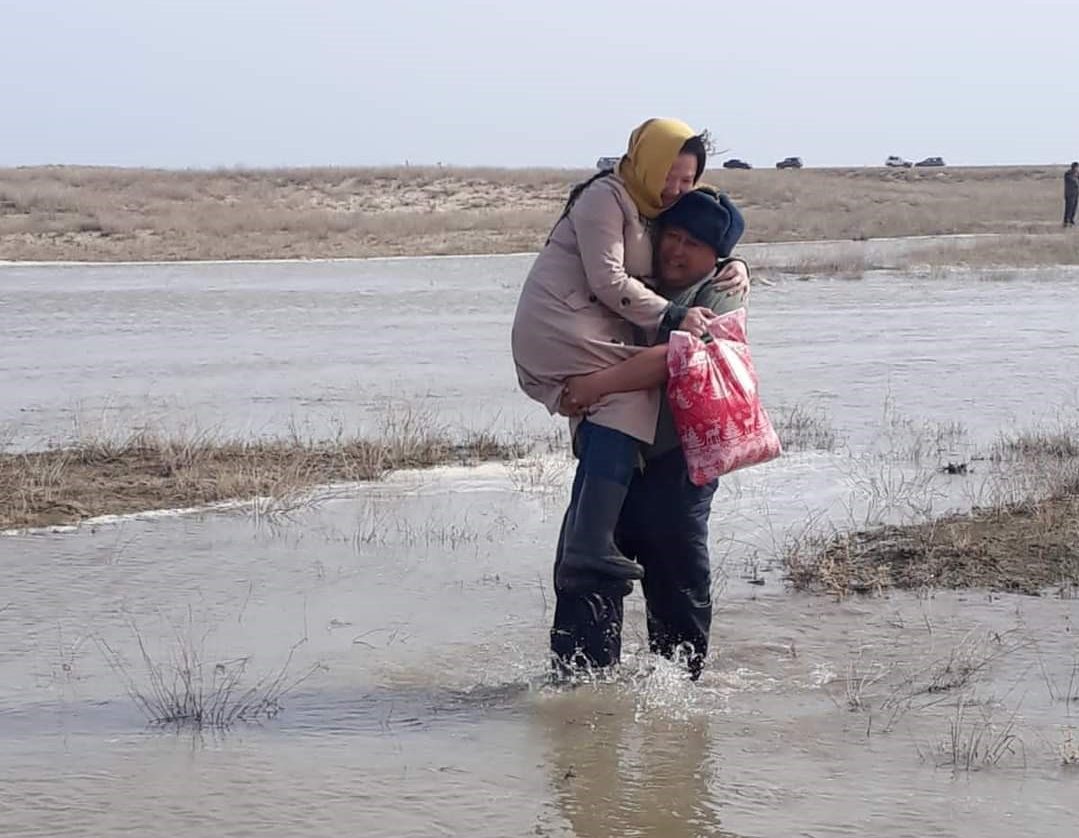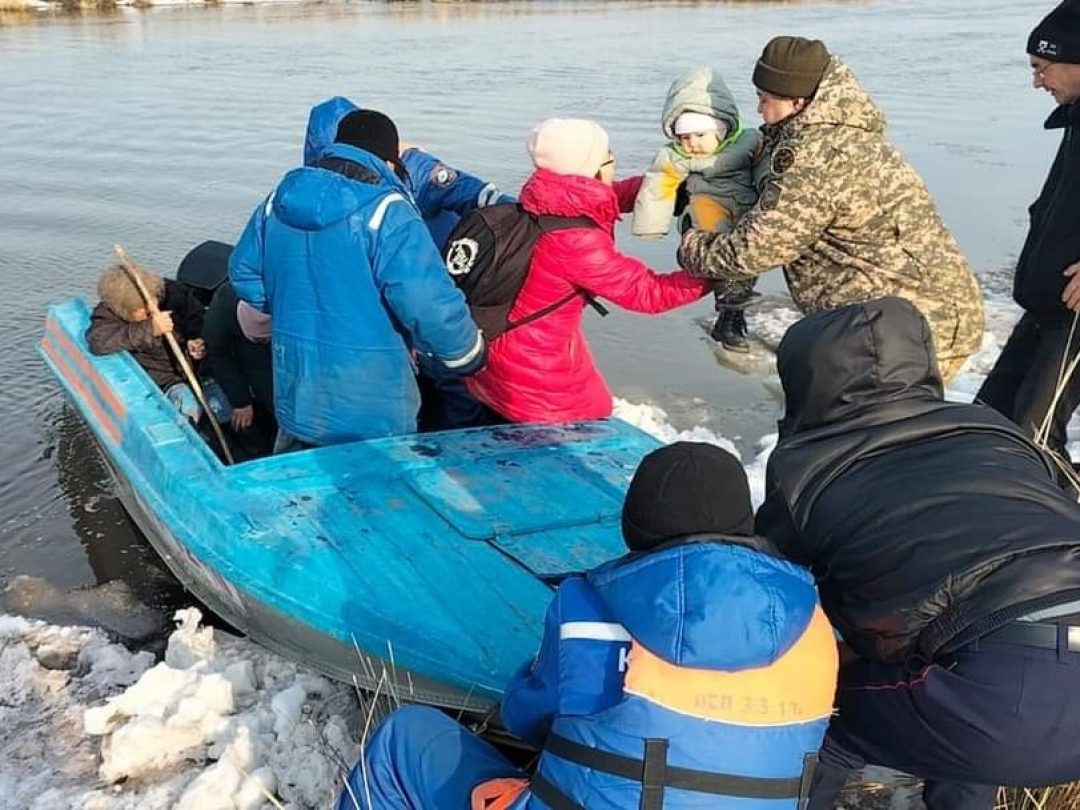Every spring in the last decade, a part of Kazakhstan gets flooded, but the authorities respond too late. This year, specialists failed to be prepared to the large-scale flooding. A part of the country sinks in thawing water, whereas the akimats of the regions fail to respond to the natural disaster.
According to the Ministry of Emergency of Kazakhstan, thawing water flooded 185 residential, 78 summer houses and two social facilities from the beginning of the flood season in Aktobe, West Kazakhstan, Pavlodar, and Karaganda regions. Rescuers evacuated 1,165 people.
Every year, the government and the management of central and local executive bodies speak about systemic measures taken to ensure water security of the country. However, the situation continues to change every spring.
West Kazakhstan region. Photo: Ardak Muratkyzy
In Aktobe, dozens of villages submerge. Rescuers even destroy roads to stop the spring flood. Almost 8 thousand children cannot attend school. A 15-year-old girl almost nearly died as she was washed off the road by floodwaters, but local residents rescued her.
In Karaganda, city dwellers tried to manage the flood themselves, but they failed to do it without special equipment. Dozens of other residential places have the same situation.

According to economist Maksat Yerniyazov, after floods houses and administrative buildings shall be reconstructed from the local and republican budgets.
“The budget allocates nearly 40 billion tenge (87.72 dollars) per year for emergency situations. The decision of emergency situation should be registered with the justice bodies and then the local budget allocates money. They also attract businessmen and philanthropists. However, they rarely pay compensation for the cattle and furniture. Who will insure the cattle for 400 thousand som (877 dollars)? Rural residents have never seen such amount because their salary in villages is 30 thousand tenge (65.79 dollars),” he said.
The loss from spring floods this year has not been counted yet. But in West Kazakhstan only, the loss in 2018 was 2 billion 205 million tenge (5.739 dollars at the rate of the National Bank of Kazakhstan as of the end of 2018). According to forecasts of economists, this year the total loss will be about 14 billion tenge.
In the interview to journalists, Ibragim Kulshimbaev, chief of Department for Emergency Situations of Karaganda region, said that discharges made from the main reservoirs are slowly increasing, and the cleaning of pipe culverts under roads is under special control.
“We have over 5,400 pipe culverts in the region. 52 per cent of them have been cleaned so far. This spring came too soon. And climate change has had its impact, but our works are nevertheless in progress,” he said.
However, according to experts, it is not relevant to refer to the climate change in this situation. The problem is with the personnel, according to hydraulic engineer Yelaman Zhaksylykov.
“Climate change is a silly reason. We used to have a great ministry – Ministry of Water Administration. Now it is one of the five committees in the Ministry of Agriculture. No one is concerned with the strategic development and planning, they do not take account of the rotation of dry years and wet years. There is no hydro technology department in any university of the country that would be preparing solid professionals, like it was in the USSR,” the expert said.

Political analyst Mukhit-Ardager Sydyknazarov also said that floods are partly the result of the decreased number of specialists directly involved in hydrosphere and related fields.
“I am speaking about scientists. It would be justified if we spoke only about southern regions where winters are usually short and less snowy. But it looks ridiculous when the authorities of northern regions, where winter lasts for six months a year, blame meteorological forecasters. Northern winter in northern regions is not something unexpected, it is rather a rule and the law of nature, geography and climate,” the expert said.
On April 7, Deputy Sergei Yershov stated to the Senate of parliament of Kazakhstan that half of hydraulic structures are in disrepair and need to be repaired or modernised.
“Condition and in some cases full absence of hydraulic structures at dams and embankments causes special concern. The majority of them were built in the 60-70s of last century and are currently worn and obsolete by 40 per cent,” he said.
According to Yershov, Kazakhstan has over 1,800 hydraulic structures. They include not only large dams, but also small dams and fuse plugs of various reservoirs. Nearly 600 facilities need close attention of specialists and full repair.
On March 11, 2010, the dam failure in the village of Kyzylagash in Almaty region became one of the most destructive floods in the history of Kazakhstan. Then the flood took lives of over 40 people, including children, 300 residents were injured and over a thousand were evacuated.

Village of Kyzylagash, 2010. Photo: Voxpopuli Kazakhstan.

Two-metre high waves washed off a few residential places in just one night. Over 250 houses collapsed because of the water head. 53 million dollars were allocated to liquidate the consequences.
According to the investigation, the dam was illegally transferred to private ownership, and its owners in an effort to store more water did not control the strength of the facility. Those found responsible were imprisoned for several years.
But the issue of flooding of residential places is still relevant. Residents of suburbs and private sector housing in Akmola, Karaganda, Kostanai, North Kazakhstan and East Kazakhstan regions every year wait for warming and the resulting floods with anxiety.




